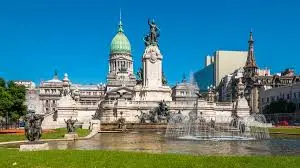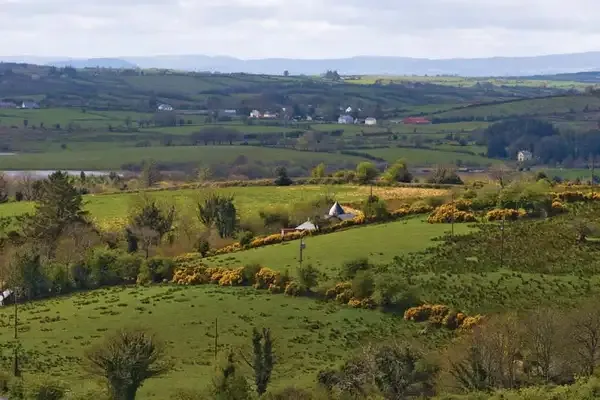9 Architectural Landmarks in Buenos Aires
Buenos Aires boasts a rich architectural heritage, blending European influences with local flair. The majestic Teatro Colón is renowned for its impeccable acoustics and opulent design. Casa Rosada, the presidential palace, captivates with its distinctive pink hue. The neoclassical Metropolitan Cathedral houses the tomb of General San Martín. Modern marvels like the Floralis Genérica, a massive metal flower sculpture, and the innovative Puente de la Mujer bridge showcase contemporary creativity. Historic neighborhoods like San Telmo and La Boca offer vibrant, colorful facades, while the grand Palacio Barolo and the ornate Palacio de Aguas Corrientes highlight the city's eclectic architectural diversity.

1. Casa Rosada
The iconic Casa Rosada serves as the executive mansion and office of the President of Argentina. Known for its distinctive pink facade, this architectural masterpiece boasts a rich history and is a symbol of Argentine political life. The building's neoclassical design, combined with elements of Italian Renaissance architecture, makes it a must-see landmark in Buenos Aires.
2. Teatro Colón
Considered one of the finest opera houses in the world, the Teatro Colón is renowned for its exceptional acoustics and stunning architecture. Opened in 1908, this landmark features a grand lobby, a magnificent auditorium, and intricate frescoes. Visitors can take guided tours to explore its opulent interiors and learn about its history as a cultural hub in Buenos Aires.
3. El Obelisco
Standing tall at 67 meters, the El Obelisco is one of the most recognizable symbols of Buenos Aires. Erected in 1936 to commemorate the 400th anniversary of the city’s founding, this monumental structure is located at the intersection of two major avenues. Its sleek, modernist design contrasts beautifully with the surrounding historic buildings.
4. Palacio Barolo
The Palacio Barolo is a stunning example of early 20th-century architecture, inspired by Dante Alighieri's "Divine Comedy." This iconic building features a blend of neo-Romanesque and neo-Gothic styles. Visitors can take a guided tour to ascend to the rooftop, which offers breathtaking views of the city and a unique perspective on its architectural landscape.
5. Basilica del Santisimo Sacramento
This beautiful basilica, the Basilica del Santisimo Sacramento, showcases an impressive blend of architectural styles, including Baroque and neoclassical elements. Its stunning stained glass windows and ornate interior make it a serene place for reflection and a highlight for architecture lovers in Buenos Aires.
6. Museum of Fine Arts (Museo Nacional de Bellas Artes)
The Museum of Fine Arts stands out not only for its extensive collection of European and Argentine art but also for its striking architectural design. The building itself features a neoclassical facade and is surrounded by beautiful gardens, creating a peaceful oasis in the bustling city. It’s a perfect spot for art enthusiasts and casual visitors alike.
7. Kavanagh Building
The Kavanagh Building is a striking example of modernist architecture in Buenos Aires. Completed in 1936, it was once the tallest building in South America. The building's sleek lines and unique design make it a focal point in the Retiro neighborhood, and it remains a significant landmark in the city’s skyline.
8. San Telmo Market
The historic San Telmo Market is not only a vibrant marketplace but also an architectural gem. Housed in a former wholesale market building from the late 19th century, it features wrought-iron structures and beautiful tiles. Visitors can enjoy local cuisine, artisanal crafts, and the lively ambiance of this cultural hotspot.
9. La Boca and Caminito
La Boca is famous for its colorful buildings and rich cultural history. The Caminito street is a vibrant open-air museum and a traditional alley that showcases the neighborhood's artistic spirit. The bold colors and eclectic architecture reflect the immigrant influence on Buenos Aires, making it a lively and photogenic destination.
Conclusion
Buenos Aires is a city that beautifully marries history and modernity through its stunning architectural landmarks. From the political significance of the Casa Rosada to the artistic flair of La Boca, each site offers a unique glimpse into the city’s rich cultural tapestry. Exploring these landmarks is not just about appreciating their beauty but also understanding the stories that shaped Buenos Aires into the vibrant metropolis it is today.
| Landmark | Architectural Style | Year Established |
|---|---|---|
| Casa Rosada | Neoclassical | 1860 |
| Teatro Colón | Neoclassical | 1908 |
| El Obelisco | Modernist | 1936 |
| Palacio Barolo | Neo-Romanesque, Neo-Gothic | 1923 |
| Basilica del Santisimo Sacramento | Baroque, Neoclassical | 1916 |
| Museum of Fine Arts | Neoclassical | 1896 |
| Kavanagh Building | Modernist | 1936 |
| San Telmo Market | 19th Century Iron Structure | 1897 |
| La Boca / Caminito | Eclectic | 20th Century |












